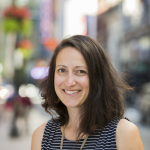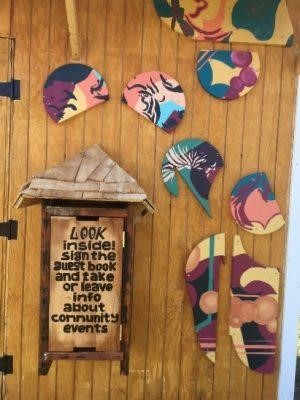A Reflection from MAPC’s First Artist-in-Residence
Posted by Jan 25, 2019

Carolyn Lewenberg
This post is part of Animating Democracy’s Inside Artist-Municipal Partnerships blog salon. Check out recent posts by Jenn Sien Erickson, Metropolitan Area Planning Council’s Manager of Arts & Culture, and Josh Silver and Sakina Khan of the DC Office of Planning, Washington, D.C.; plus six others published in 2018.
In 2017, the Metropolitan Area Planning Council (MAPC) hired Carolyn Lewenberg as its first artist in residence. The goal of MAPC’s Artist-in-Residence Program is to bring arts, culture, and creativity into the agency’s multidisciplinary planning work with cities, towns, and other organizations in the Metropolitan Boston area. By tapping the talents and perspectives of a visiting artist, the residency aims to infuse arts, culture, and creativity into project scoping and implementation while enriching and expanding the creative practice of the visiting artist. In November 2018, Carolyn’s 18-month residency came to end and she reflected on her experience in a blog for MAPC’s website. This slightly abridged version is a perfect tandem piece to a blog published Jan. 24 on ARTSblog by Jenn Erickson, MAPC’s Arts and Culture Manager, about the development of the Arts & Culture division at MAPC.
Over the last 18 months I’ve gotten to work with 10 different planners at MAPC in a variety of departments: Land Use, Public Health, Environment, Government Affairs, and Strategic Initiatives. I was also involved in project development conversations with Municipal Collaboration, Transportation, Clean Energy, and Data Services. (See a full list of the Artist in Residence projects completed.)
Many of these projects grew out of the conversations I had in the first couple months of my residency, when I met with directors from all the dynamic practice areas at MAPC about how they imagined arts and culture could be woven into their work. I was inspired by the depth and breadth of their focus areas, and the opportunity to not just to imagine possibilities together, but to put the ideas in action, was very exciting.
During this same period of getting to know MAPC, Arts and Culture Manager Jenn Erickson, Senior Arts and Culture Planner Annis Sengupta, and I explored our values and our reasons for coming into this work and began to develop a foundation of team values that would drive our work together. The intentionality in the space that Jenn created for these conversations was grounding and instructive of future conversations we would have with different communities, which would drive the different projects forward.
Jenn provided guidance throughout my entire residency to help me learn the culture at MAPC and how to be effective in working within this context, encouraging me to be reflective about my work, to pursue projects that would be meaningful, and to develop skills to scope out projects. Jenn’s in-depth understanding of MAPC allowed me to leverage momentum of existing projects with other departments, build on relationships with different municipalities, and find allies within the agency who have passion for art and creativity.
Annis is a team player and collaborative leader who demonstrated patience and brilliant insights into the complexities of arts and culture planning work. Annis’s willingness to bounce around ideas with me was major in shaping the direction of projects. Her ability to translate our work into presentations, graphic materials, and written reports was amazing.
At MAPC, all time is accounted for. The chart below shows how my time shook out.
While accounting for time spent in a creative process was a huge challenge, having this information helped me process my experience and capture some important takeaways. These include:
- Project development and planning time has taken about 13 percent of my time. This is really hard to account for and be compensated for as a freelancer.
- Staff meetings accounted for nine percent of my time. This time can also be overlooked in project development; but being intentional at the outset that a collaborative spirit will drive the work is key.
- We gave a lot of presentations and workshops! I was encouraged to carve out time for reflection. This reflective practice was a key part of presentations and workshops.
 Prior to this experience, I hadn’t really considered how different it would be to have an artistic practice based out of a government planning agency. Instead of my studio-based practice of playing with materials, exploring a site, having conversations with people who have personal connections with a place, and allowing an inclusive process to emerge, the experimentation and play at MAPC happened through collaborative conversations with planners whose perspectives were supported by research and data. From there I would connect with community, once the general vision for the project was articulated. Driven by a creative problem-solving framework, the artistic process was highly structured and articulated in advance of community engagement. I struggled to navigate this structure in a way that would allow for flexibility once community engagement began, and I learned what community members and resources would support the work and offer new directions that made sense for the process, product, and site.
Prior to this experience, I hadn’t really considered how different it would be to have an artistic practice based out of a government planning agency. Instead of my studio-based practice of playing with materials, exploring a site, having conversations with people who have personal connections with a place, and allowing an inclusive process to emerge, the experimentation and play at MAPC happened through collaborative conversations with planners whose perspectives were supported by research and data. From there I would connect with community, once the general vision for the project was articulated. Driven by a creative problem-solving framework, the artistic process was highly structured and articulated in advance of community engagement. I struggled to navigate this structure in a way that would allow for flexibility once community engagement began, and I learned what community members and resources would support the work and offer new directions that made sense for the process, product, and site.
As I reflect, I also think about people outside MAPC I had the privilege to work with: the teens in Everett with neon orange shirts applying polyurethane to the waterdrop sculpture, people sharing their collages at creative placemaking workshops, and guests from Providence talking about public health at the discussion series. I’ve met so many community members, leaders, and youth who shape our region. It’s been a rich residency and I am grateful for the experience.
Follow Carolyn’s future activities at carolynl.net.





